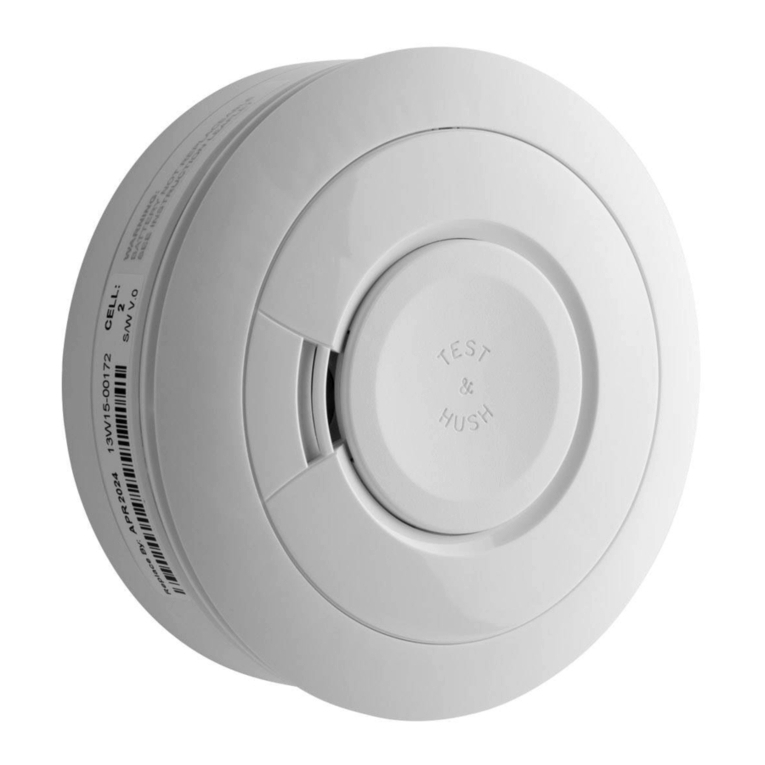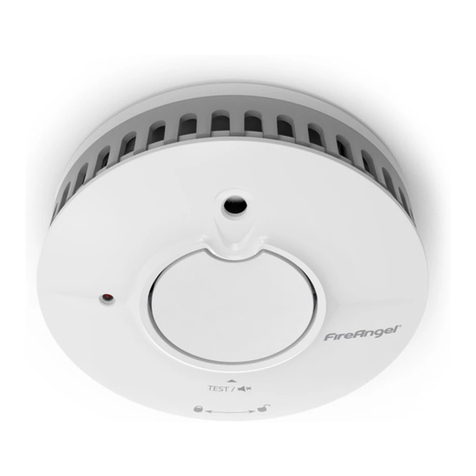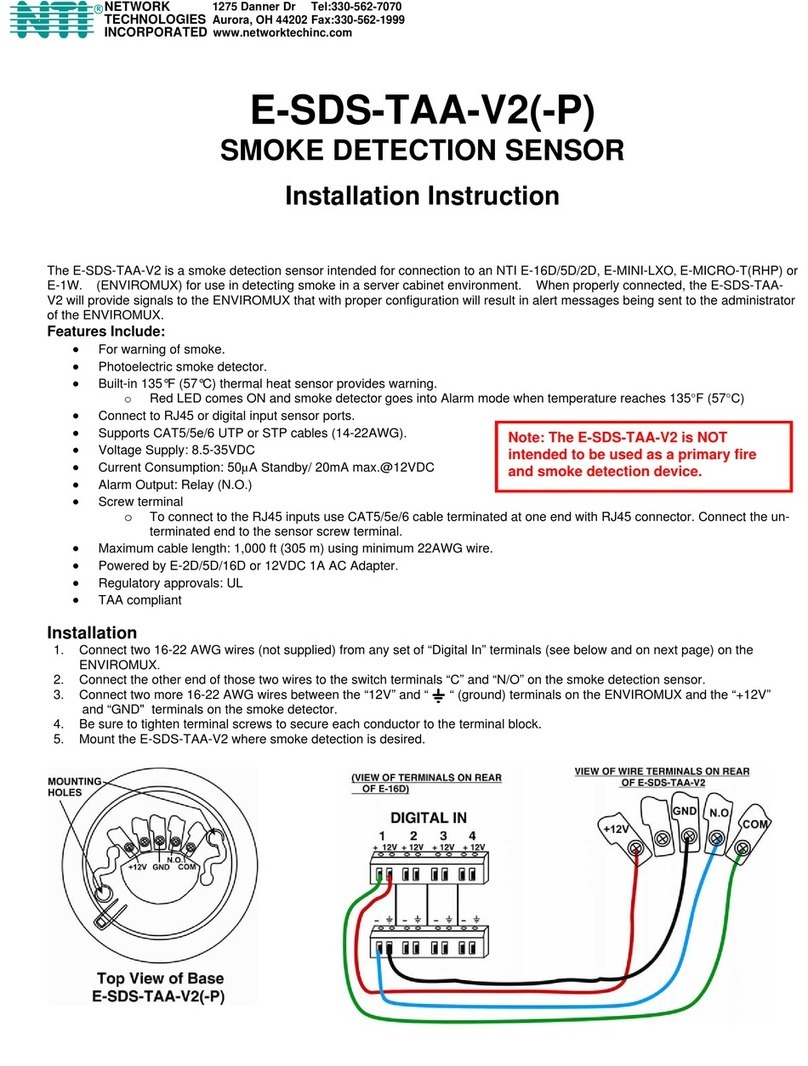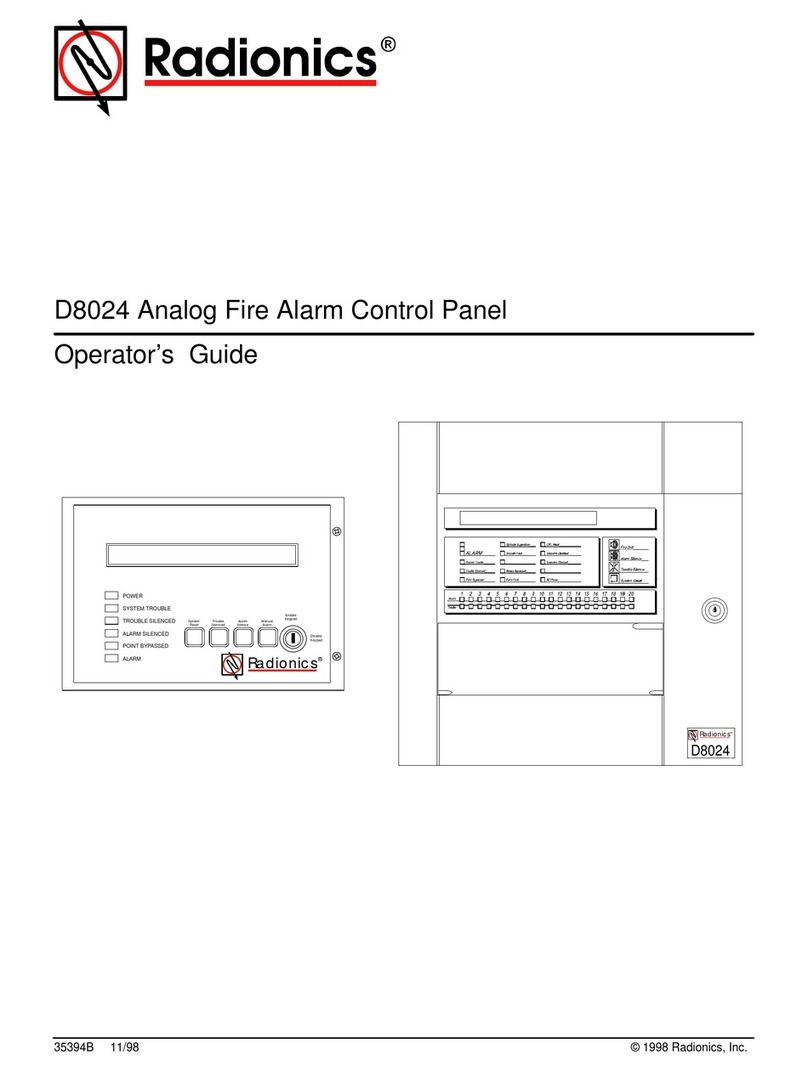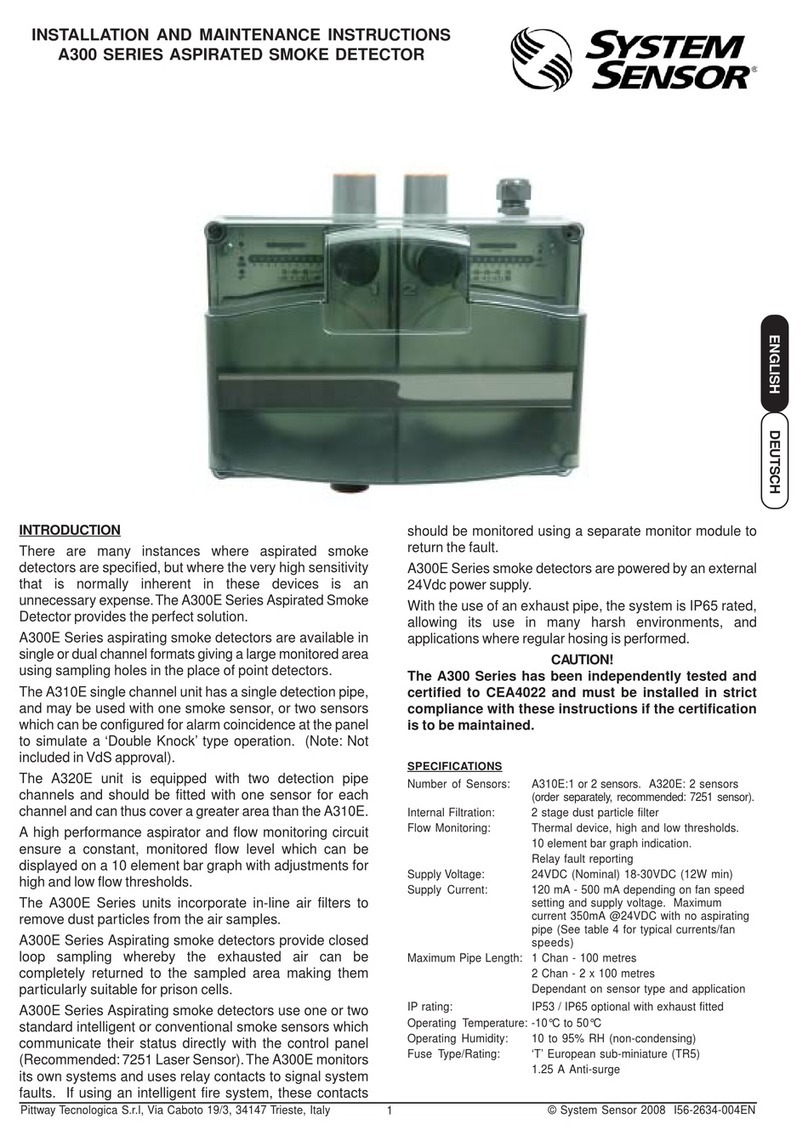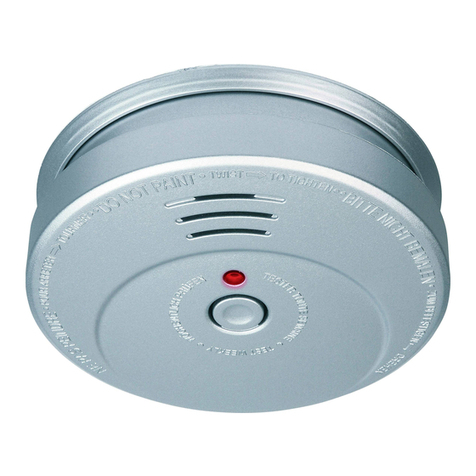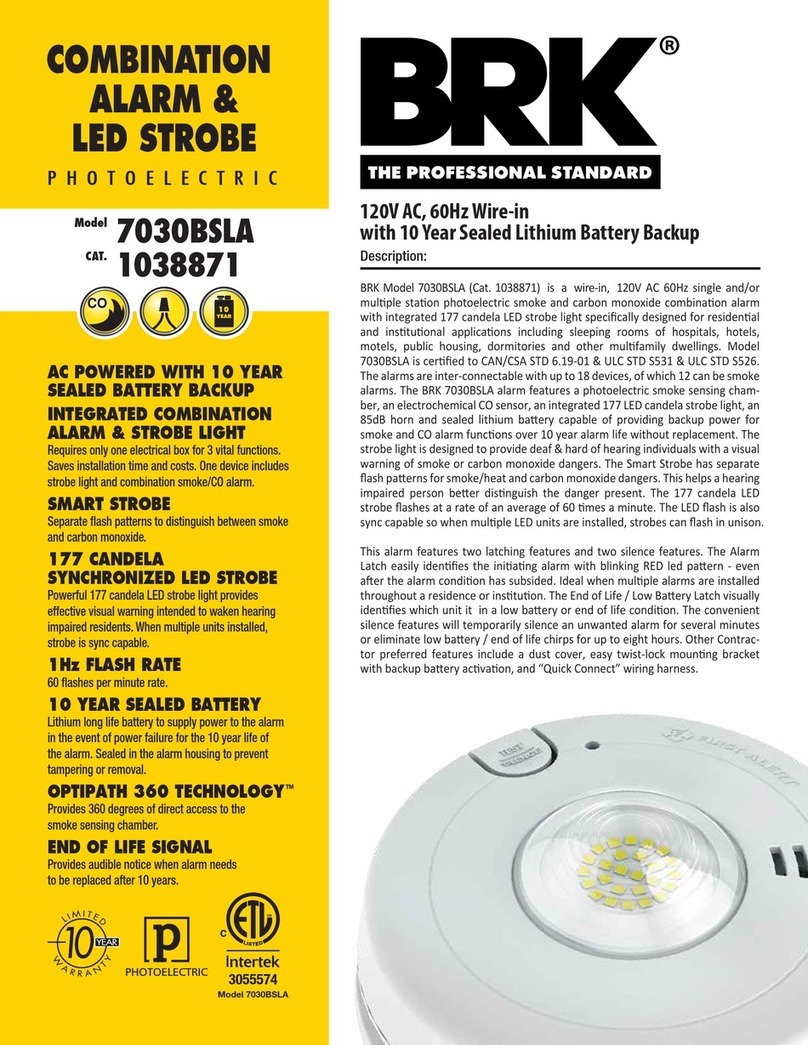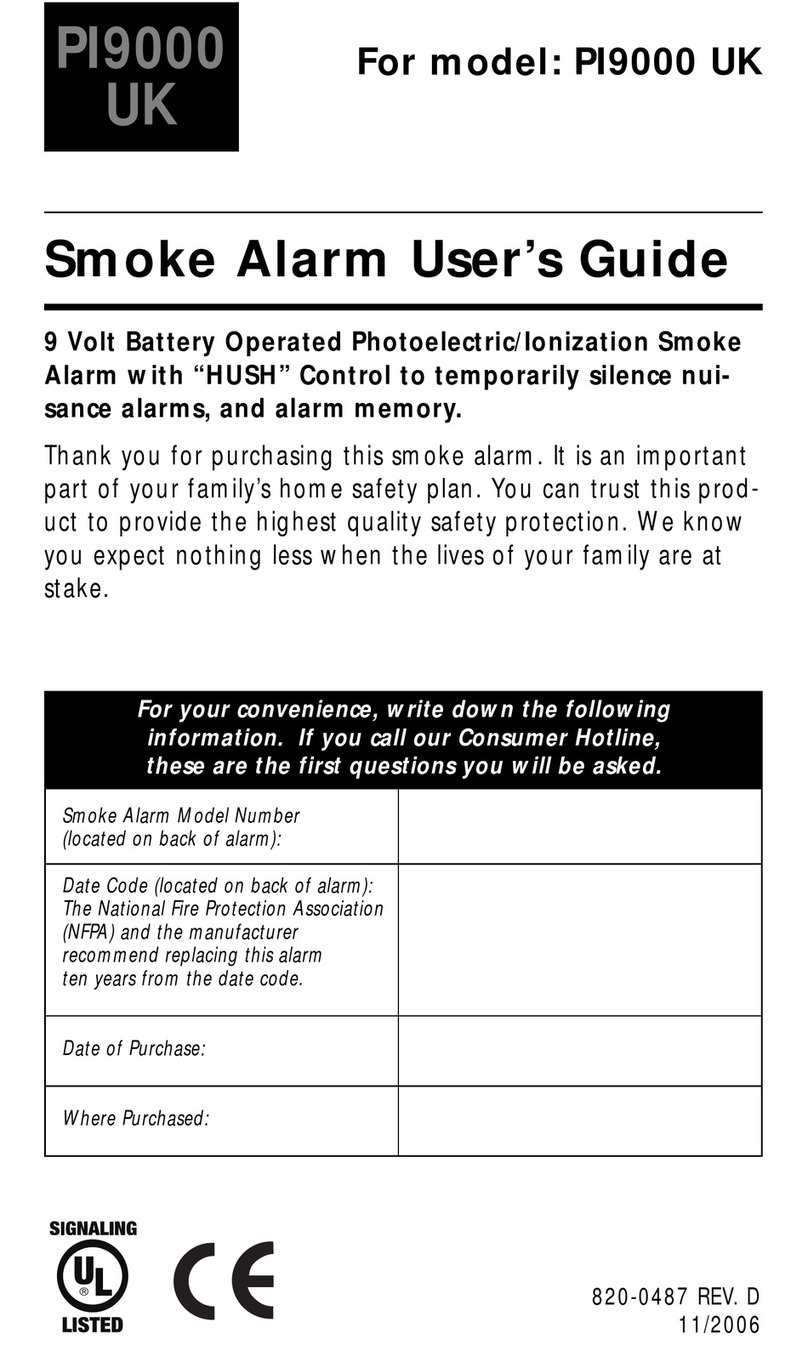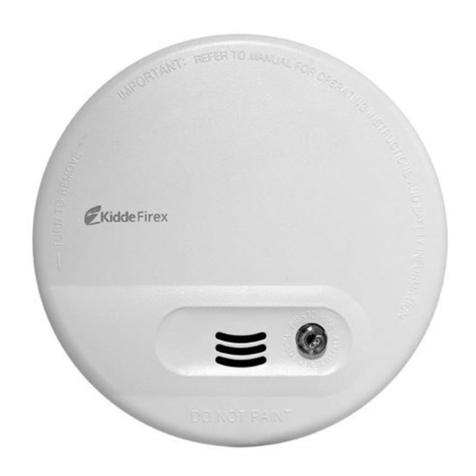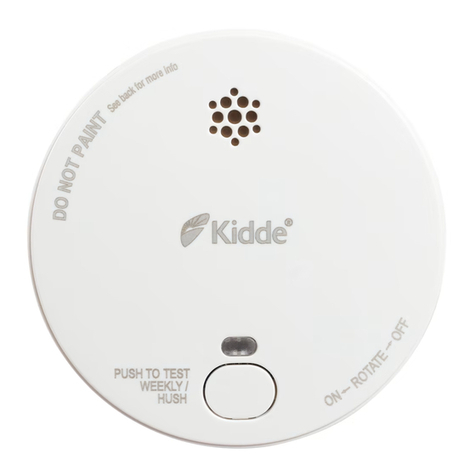Ffeuk F3K User manual

End To End
Optical Beam Smoke Detector
User Guide
EN

2
1.General Information
>30cm
>30cm
Transmitter Receiver
Power
Supply Unit Controller
5 - 120m
•IMP RTANT N TE: The infrared beam path MUST be kept clear of obstructions at all
times! Failure to comply may result in the system initiating a Fire or Fault signal.
• All installations should comply with local regulations
• For installations approved to UL 268 refer to NFPA 72 for installation guidance. In such
installations, it is advised that the maximum distance of Transmitter and Receiver from the
ceiling must be 10% of the distance between floor and ceiling
• nsure a clear line of sight from Receiver to Transmitter
• Mount on solid surfaces (structural wall or girder) and ensure fixing is rigid
• Position beam as high as possible, but with a minimum distance of 30cm from
Receiver/Transmitter to ceiling
• Mount Receiver and Transmitter directly opposite each other
• Do NOT position where personnel or objects can enter the beam path
• Do NOT install the Transmitter or Receiver in environments where condensation or icing are
likely to occur
nsure clear line of
sight from Receiver
to Transmitter

3
• Note 1: This component is the fire resistor. Its value is specified by the Fire Control Panel
manufacturer. For U.S. installations it is typically a short circuit
• ALWAYS use a separate 2-core cable for each Receiver head
• CAUTION: For system monitoring - Do not use looped wire under any terminals. Break wire
run to provide monitoring of connections
• Components not supplied:
• nd Of Line (' OL') component - supplied by Fire Control Panel manufacturer
• Fire Resistor
• After installation, check operation of Fire and Fault connection on Fire Panel
• Apply a voltage of 5V to 40V to ‘ XT RST’ contact for at least 2 seconds to clear a latched
fire condition
• For wiring to other types of Fire Control Panel, or to wire multiple Controllers onto one Zone,
refer to additional installation instructions supplied with the product
2. Wiring Diagrams
RC IV R 1
OUTPUT
+-
R C IV R 2
OUTPUT
+ -
TRANSMITT R
SUPPLY
+ -
TRANSMITT R
SUPPLY
+ -
12V to 36V DC
R C IV R 1
FIR
N/O COM N/C
R C IV R 1
FAULT
N/O COM N/C
RC IV R 2
FIR
N/O COM N/C
R C IV R 2
FAULT
N/O COM N/C
R C IV R 1
FIR
N/O COM N/C
R C IV R 1
FAULT
N/O COM N/C
R C IV R 2
FIR
N/O COM N/C
R C IV R 2
FAULT
N/O COM N/C
see note 1
see note 1
OL
OL
see note 1
OL
XT RNAL
RS T
XT
RST
ZON 1 -
ZON 1 +
ZON 2 -
ZON 2 +
SUPPLY -
SUPPLY +
ZON 1 -
ZON 1 +
For connection of two Receivers to one zone:
Wiring two Receivers onto two zones:

4
3. Fitting the Product
L D indicator must face
downward
- +
TO ‘R C IV R
OUTPUT’ ON
CONTROLL R
BOARD
RC IV R:
- +
TO
12 to 36V SUPPLY OR
‘TRANSMITT R SUPPLY’
ON CONTROLL R
BOARD
TRANSMITT R:

5
N TE: ne System Controller can be used to control and monitor up to two Receiver
heads. The ‘#’ symbol in this guide is used to represent the number of the Receiver
currently selected (1 or 2).
Apply Power to Controller,
Receiver(s) & Transmitter
4. Apply Power
• Commissioned System:
• Communications fault, or no Receiver connected:
• Receivers are not found (normal at this stage):
• Receivers have been found but not commissioned:
3 seconds

6
Default Pass Code: 1234
Press to enter PASS COD SCR N in US R M NU
Change digit
Move between digits
Accept
5. Enter Pass Code to Access Engineering Menu
• An incorrect Pass Code will return the
display to the Pass Code entry screen
• Three incorrect attempts will lock access for
three minutes
• Perform 'Find' during initial installation, or when adding or removing Receivers
6. Finding Receivers
• Press to enable ‘Found’ Receivers
• Any unused Receiver channels are switched off
• Press to re-scan if the number is incorrect
This will be the number of
Receivers found
10 seconds

7
• All Receivers need to be aligned separately
• Steps 8 and 9 explain how to align individual Receivers
7. Select Receiver to be Accessed
• The LAS R in the Receiver head is used to align the Receiver with the Transmitter.
• The LAS R can be activated using the button on the Receiver head whilst in ngineering
Menu, or via the LAS R icon in the NGIN RING M NU as shown below.
• Move the LAS R as close to the Transmitter as possible, by moving the Receiver’s
thumbwheels
• The system will signal Fault while in this mode
8. LASER Targeting
The LAS R TIM OUT
value (MIN=1 min.;
MAX=59 mins.) may be
incremented or
decremented in 1 min.
steps by using:
Countdown lapsed
LAS R RADIATION - AVOID
DIR CT Y XPOSUR
POW R OUTPUT < 5mW
CLASS 3R LAS R
Wavelength 630 - 680 nm
DANG R
If it is not possible to see the LAS R because of the installation environment (for example, if
there is high ambient light) then align the Receiver by eye so that it is pointing at the
Transmitter.
2-
1-

9. Alignment
Step 1
In installation mode you are centring the Transmitter beam onto the Receiver and the system is
adjusting its power for optimum signal.
Step 2
No flash No flash
Reduce Tx
power
Step 3
Adjust thumbwheels
(SEE N TE 1)
Set Tx power to
maximum.
Signal too
high
View L Ds on Rx or
LCD value
Amber -
short/long flash
No flash
Green - short/long
flash
Signal too
low
N TE 1: Value can be
between 2 and 178.
A higher value means a
better alignment.
Proceed to Step 4
Tx
Rx
Rx
Tx Tx
Rx
8

Green - flash/stop
Green - flash/stop
9
Signal
increased
Signal
decreased
Amber -
flash/stop
LCD value
decreases
Amber - flash/stop
Green - flash/stop
Green - short/long
flash
LCD = 180 LCD value
increases
L D - no flash
LCD = between 2
and 178
Adjust one
thumbwheel by
1/4 turn.
Adjust same thumbwheel by
1/4 turn in the opposite
direction.
Press tick to accept
alignment
Repeat step 4 for the other
thumb-wheel
Adjust same thumbwheel by 1/8 turn in
the opposite direction
Adjust same thumbwheel by 1/4 turn
in the same direction. Release thumb-
wheel and wait 1 second.
(SEE N TE 1) (SEE N TE 1)
Reduce Tx
power
Tx
Tx
Tx
Tx
Tx
Rx Rx
View L Ds on Rx or
LCD value
View L Ds on Rx or
LCD value
Step 4
N TE 1: Value can be
between 2 and 178.
A higher value means a
better alignment.
From Step 3

10
10. Manual Fire and Fault Tests
After installation or cleaning, it is recommended that a Manual Fire and Fault test is performed:
Fire Test: Slowly half-cover the Receiver. The Controller will indicate Fire after the Fire Delay
Time.
Uncover the Receiver. The Controller will return to Normal state after approximately 5 seconds.
Fault Test: Completely cover the Receiver taking less than 2 seconds to do so. The Controller
will indicate Fault after the Fault Delay time.
Uncover the Receiver. The Controller will return to Normal state after approximately 5 seconds.
11. Remote Fire Test
The Remote Fire Test allows the user to perform a Fire Test from the System Controller.
The Remote Fire Test is acceptable for Fire Authority Acceptance and Routine Maintenance per
UL 268-5.
Receiver Fire LED Test
The Receiver will signal 'Fire',
the System Controller will stay
Normal.
Press to exit without
performing the test.
Relay / Controller Wiring Test
The System Controller signals
'Fire' to the Fire Control Panel.
Press or to exit.

11
12. Fire Threshold
This setting is the threshold at which the Receiver will detect a fire. Default factory setting=35%.
(Set for each Receiver).
• Sensitivity can be adjusted in 1% steps by pressing up or down keys
• Press to accept setting
UL268 Fire Threshold Ranges:
EN Approved Sensitivity Ranges:
Distance betweenTransmitter
and Receiver
Fire Threshold Range
5 - 10m (16.4 - 32.8 ft ) 25%
10 - 20m (32.8 - 65.6 ft ) 25 - 30%
20 - 40m (65.6 - 131.2 ft ) 25 - 45%
40 - 60m (131.2 - 196.8 ft ) 35 - 60%
60 - 80m (196.8 - 262.5 ft ) 45 - 60%
80 - 100m (262.5 - 328.1 ft ) 55 - 60%
100 - 120m (328.1 - 393.7 ft ) 60 %
Complies with N54-12 for sensitivity levels between 25% and 35%, with a maximum delay to
fire of 20 seconds

12
13. Delay To Fire
This setting is the delay the System Controller uses before signalling a FIR condition to the
Fire Control Panel. Default factory setting=10 seconds.
(Set for each Receiver).
14. Delay To Fault
This setting is the delay the System Controller uses before signalling a FAULT condition to the
Fire Control Panel. Default factory setting=10 seconds.
(Set for each Receiver).
15. Latching/Non-Latching Mode
In Latching Mode the system will stay in Fire condition after the fire clears. In Non-Latching
Mode the system will automatically return to normal condition after the fire clears
Default factory setting=Non-Latching (Set for each Receiver).
To clear a latched fire, apply 5-40V to the xternal Reset terminal, enter the passcode, or
power cycle for 20s.
Use to move between icons in
the Receiver Menu, until the graph and bell
icons are shown
Non-Latching
Latching

13
The system will automatically compensate for dust build-up by changing the Compensation
Level. However, it is recommended that the Receiver lenses are cleaned periodically with a soft
lint-free cloth.
The system should be isolated from the Fire Control Panel before cleaning takes place. After
cleaning, verify that the system is operating normally by following the Alignment procedure and
the Fire and Fault Tests described in this User Guide.
16. Cleaning The System

14
-00 AIM not recognised Refer to manufacturer for further technical
assistance
-01 Receiver Communications Fault Check wiring between Controller and
Receiver
-02 ‘Find’ not successfully executed Follow ‘Find’ process
-03 Compensation limit reached Clean and re-align system
-04 Receiver missed too many readings, or lost
sync with the Transmitter
nsure clear line of sight from Transmitter to
Receiver
-05 Receiver is not aligned Follow alignment procedure
-06 Rapid bscuration Fault nsure clear line of sight from Transmitter to
Receiver
-07 Signal High Fault nsure there is no stray light from another source
-15 Signal too low at end of alignment nsure clear line of sight from Transmitter to
Receiver. nsure alignment of Transmitter AND
Receiver. Do not exit whilst alignment status L Ds
are still flashing
-16 Signal too high at end of alignment Follow alignment procedure again. Do not exit
whilst alignment status L Ds are still flashing
-18 Short circuit detected on communications
between Controller and Receiver
Check wiring between Controller and Receiver
-19 IR signal integrity fault Check there are no strong sources of light near the
Receiver, or direct sunlight
-20 Ambient light fault Check there are no strong sources of light near the
Receiver, or direct sunlight
-21 Power too low fault Check power supply to Controller
17. Troubleshooting

15
18. Technical Specifications
Parameter Value
Operating Distance between Transmitter and Receiver 5 - 120m
Operating Voltage Range 12 to 36V DC +/- 10%
Transmitter Current 8mA
Quiescent Current (Controller with 1 or 2 Receivers) 14mA
Alarm Current (Controller with 1 or 2 Receivers) 14mA
Fault Current (Controller with 1 or 2 Receivers) 14mA
Power Down Reset Time >20 seconds
Fire and Fault Relay Contacts VFCO 2A@ 30 Volts DC, resistive
Maximum Cable Length (Controller to Receiver) 100m
Cable Gauge 24 - 14 AWG
0.5 - 1.6mm
Operating Temperature -10°C to +55°C (non-condensing)- N
-20°C to +55°C (non-condensing)- UL
Storage Temperature -40°C to +85°C (non-condensing)
Receiver Tolerance to Beam Misalignment at 25% sensitivity ± 2.5°
Transmitter Tolerance to Beam Misalignment at 25% sensitivity ± 0.7°
Fire Threshold Range 0.45 - 3.98 dB
10 - 60%
Delays to Fire and Fault 2-30s, individually selectable
Optical Wavelength 850nm
Rapid Obscuration Fault Threshold 85%
L D Indications - Control Unit
Red = Fire (one for each Receiver)
Amber = Fault (one for each Receiver)
Green = System OK
L D Indications - Receiver Red = Fire. Green and Amber indication L Ds for
single-person alignment
IP Rating IP54
Relative Humidity (Max.) 93%, (non-condensing)
CPD Reference 0786-CPD-21162
UL File S3417 (volume 6)
Housing Construction (Controller/Transmitter/Receiver) UL94 V0 PC
Dimensions Width,
mm (in)
Height,
mm (in)
Depth,
mm (in)
Weight,
kg (lb)
Control Unit 202.7 (7.98) 124 (4.9) 71.5 (2.82) 0.606 (1.34)
Transmitter & Receiver 77.6 (3.05) 77.6 (3.05) 160 (6.3) 0.207 (0.46)
inc. brackets

Document Number: 0044-047-02- N
Table of contents
Popular Smoke Alarm manuals by other brands
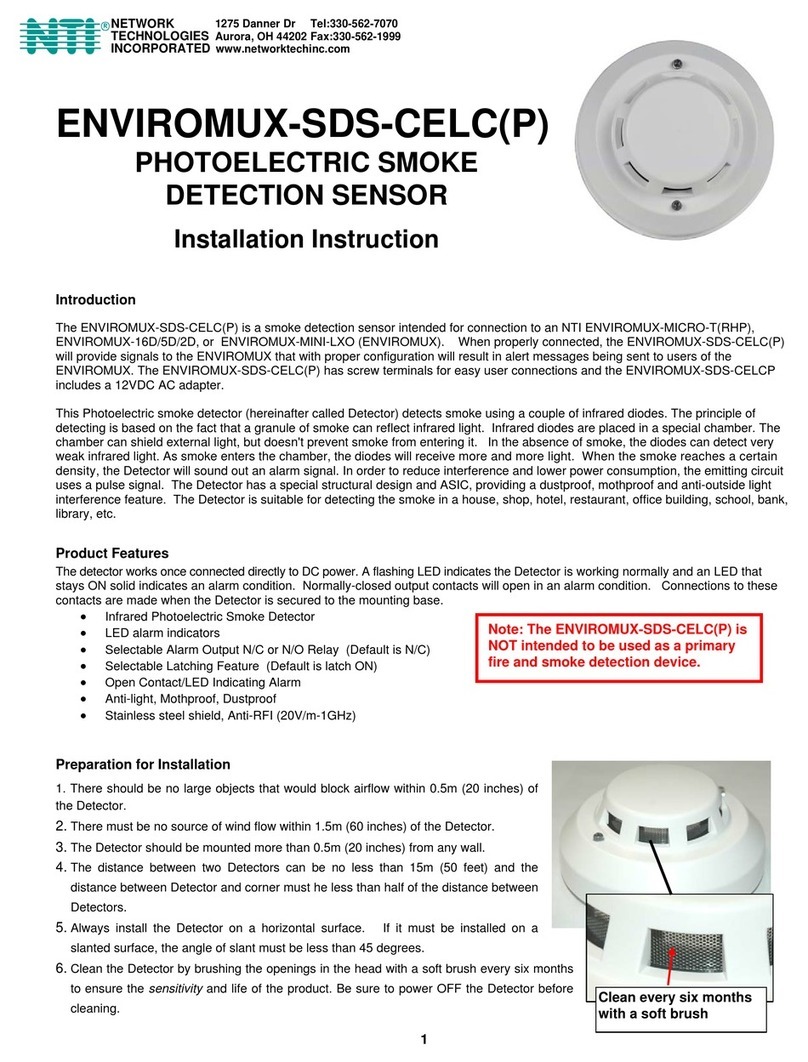
Network Technologies Incorporated
Network Technologies Incorporated ENVIROMUX-SDS-CELC Installation instruction

First Alert
First Alert SA3210 user manual
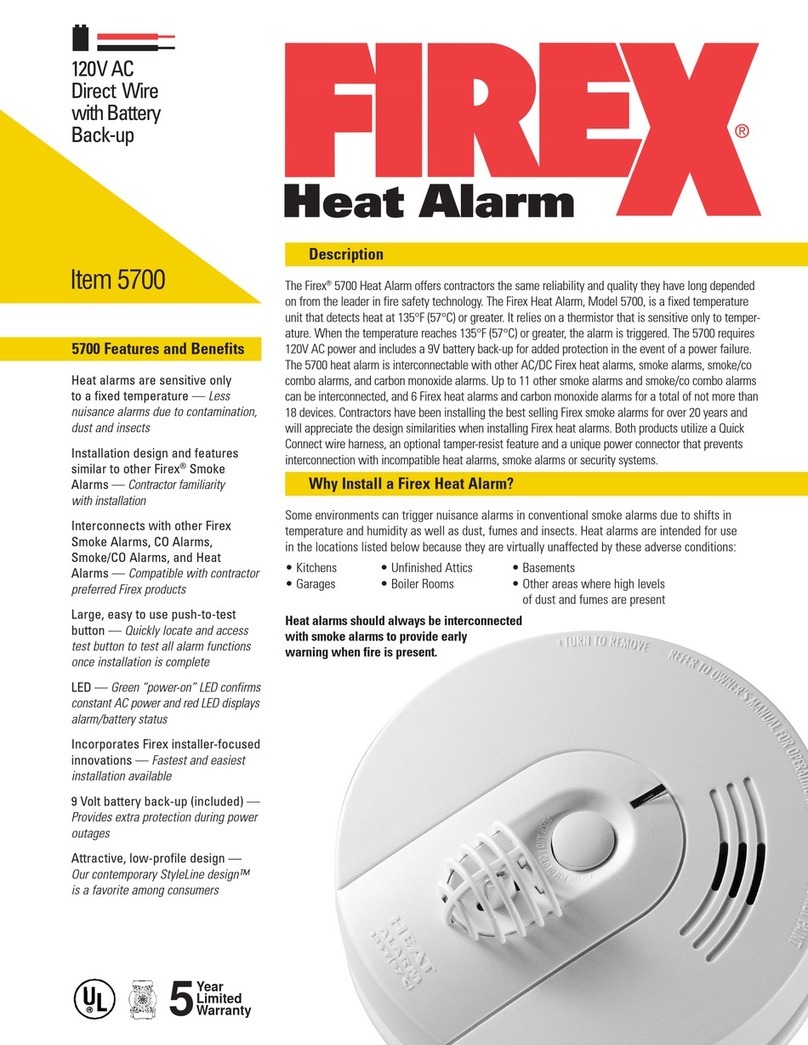
Firex
Firex 5700 Specification sheet

Bosch
Bosch D296 Series Application guide

Maverick
Maverick ET-733 REDI CHEK manual
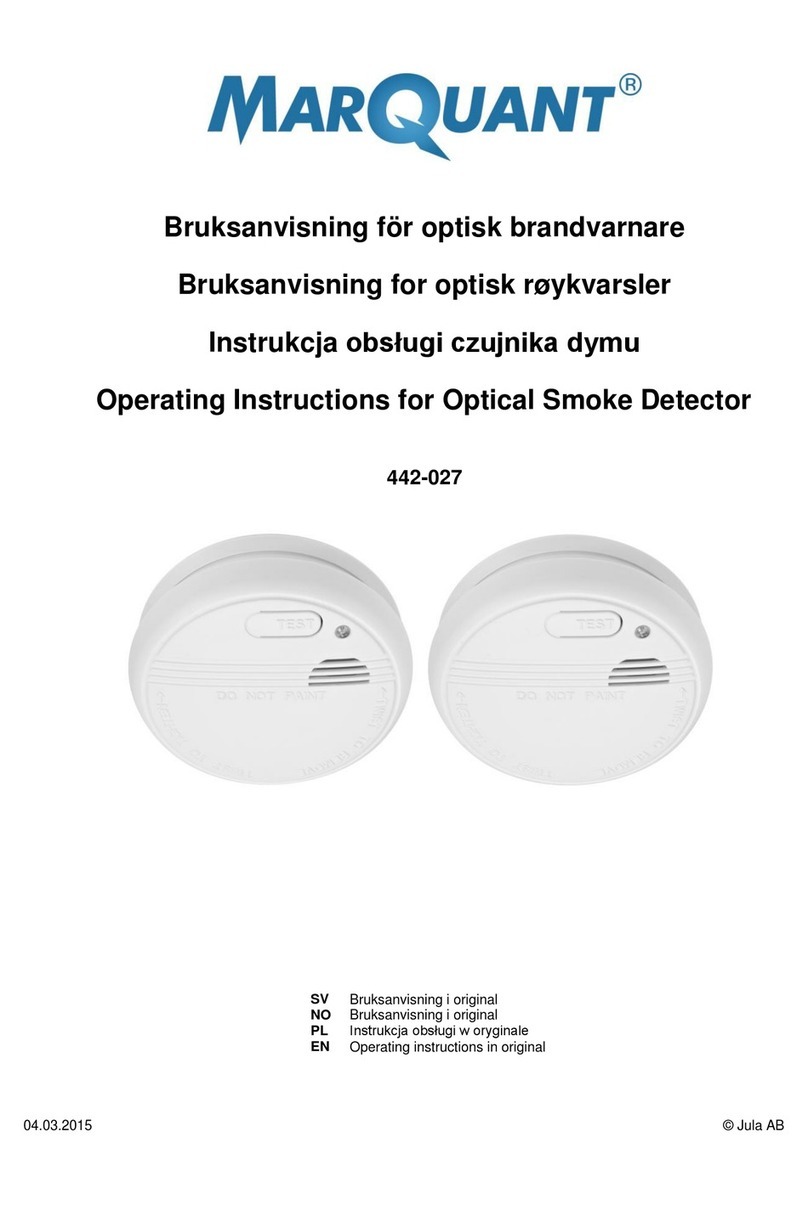
Marquant
Marquant 442-027 operating instructions
